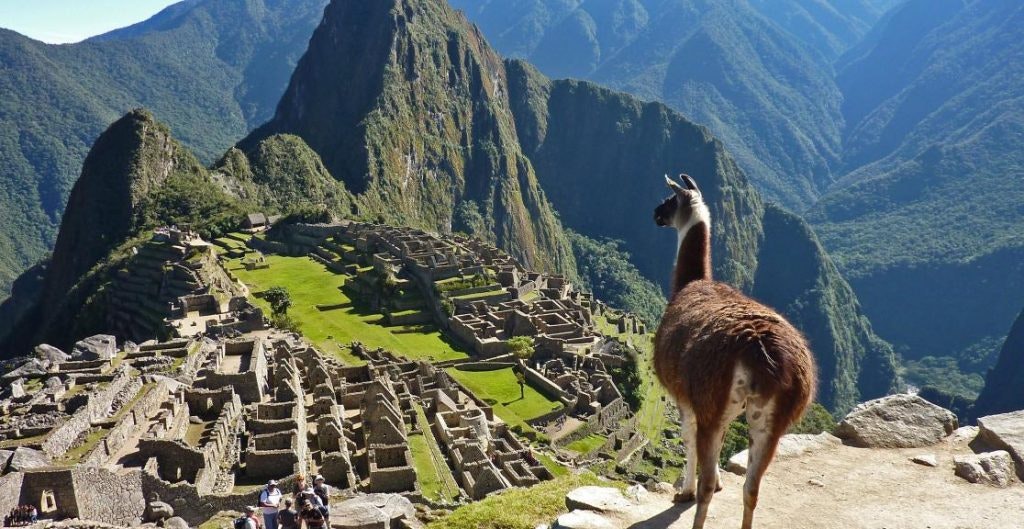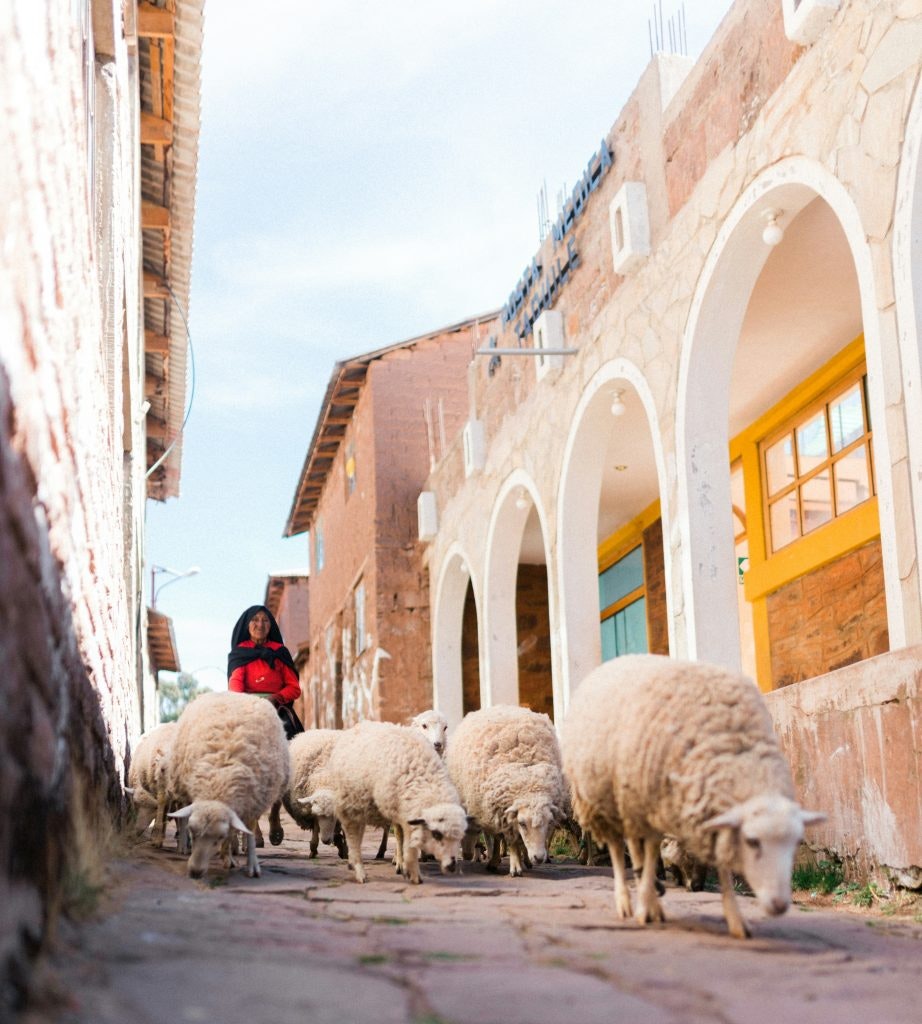







Peru is the third largest country in South America, after Brazil and Argentina. The nation is home to the Andean condor, one of the largest flying birds, and a significant part of the Amazon Rainforest.
The country’s cultural diversity is reflected in its three official languages, Spanish, Quechua, and Aymara, alongside more than 70 indigenous languages. This diversity extends to Peruvian cuisine, which features dishes like roasted guinea pig, ceviche and lomo saltado (stir-fried beef).
The Peruvian Andes Mountains make up the spine of the nation, where travelers can hike the famous Inca Trail. Within these mountains lies the Sacred Valley, which cradles the ancient city of Machu Picchu, one of the world’s greatest archaeological mysteries.
As you learn when you travel to Peru, the country’s natural world encompasses diverse ecosystems, from cloud forests to alpine tundra.
In the Peruvian highlands, temperatures fluctuate dramatically between day and night and locals preserve traditions dating back centuries, including weaving and wearing the traditional Peruvian poncho made from alpaca wool with region-specific patterns and colors to indicate the wearer’s community and social status.
 Peru has a diverse range of natural landscapes, from natural wonders such as the mighty Amazon River and the hyper-arid coastal sands of the Sechura desert, to the lush surroundings of the Amazon rainforest. However, one of the most popular tourist destinations in Peru is Vinicunca, also known as the Mountain of Seven Colors or Rainbow Mountain, a stunning natural landmark in the Andes Mountains. There are plenty of reasons to visit Rainbow Mountain, whether you want to take in this natural treasure or want a killer Instagram photo.
Peru has a diverse range of natural landscapes, from natural wonders such as the mighty Amazon River and the hyper-arid coastal sands of the Sechura desert, to the lush surroundings of the Amazon rainforest. However, one of the most popular tourist destinations in Peru is Vinicunca, also known as the Mountain of Seven Colors or Rainbow Mountain, a stunning natural landmark in the Andes Mountains. There are plenty of reasons to visit Rainbow Mountain, whether you want to take in this natural treasure or want a killer Instagram photo.
Its vibrant, colorful stripes owe to its layers of 14 different minerals, which were mixed with water from the melting ice that once covered the mountains. Though photos of Vinicunca tend to be heavily enhanced to bring out the colors of the mountain, visitors won’t be disappointed with this Rainbow Mountain in its natural state. And thanks to its location south of Cusco, it’s a good place to stop by on your way to or from Machu Picchu.
Peru is home to 87% of the world’s alpaca population, with millions of these wooly creatures living in the country. They’re not new to the region, either. These adorable mammals, part of the camel family, were domesticated by the Incas thousands of years ago. Though they were almost wiped out by the Spanish conquistadors, who arrived in 1532, the population started to grow again in the early 1900s. Today they’re raised for their wool, as well as their meat, which is high in protein and low in fat.
Machu Picchu, standing in the center of a stunning tropical mountain forest, is at the top of every traveler’s bucket list. One of the new seven wonders of the world, Machu Picchu is so impressive that UNESCO has described it as “… among the greatest artistic, architectural and land use achievements anywhere and the most significant tangible legacy of the Inca civilization.” It was thought to be the “Lost City” of the Incas, though this is disputed.
Machu Picchu is an impressive example of human creation, not least because it was constructed without the use of the wheel, meaning that the Incas had to transport these heavy rocks up the mountain using other methods. The bricks were also cut to fit tightly together using the Incas’ ashlar technique, which allows walls to be constructed without mortar.

On Taquile Island on Peru’s side of Lake Titicaca, a man is judged by his ability to knit. The skill is passed down from fathers to sons and the men of the island are responsible for producing the island’s knitted hats, called chullo. These traditional knitted hats can be used to communicate a man’s marital status or his aspirations. Not only this, the quality of a man’s chullo can determine whether or not he attracts a bride. One of the desired qualities of a chullo is that the knit is tight enough that one can use the hat to carry water.
Both men and women on the island produce textiles — women more commonly weave — and these textiles have been considered so valuable that UNESCO included them on its list of the Intangible Cultural Heritage of Humanity. Not only have these textiles drawn the attention of UNESCO, they have also pulled in tourists eager to access this collection of beautiful fabrics.

Archaeologist Julio Tello’s discovery of elongated skulls in Paracas (Quechua for ‘sandstorms’) in the late 1920s gave us insight into the ancient practice of cranial deformation. Theories about these unusual, conical skulls have sparked theories about alien lifeforms in recent years, going as far as to prompt USA Today to publish a Fact Check story debunking these claims in 2021.
The camu camu fruit has a significant amount of vitamin C, ranging between 2,000-3,000 mg per 100g of fruit pulp. Grown in the Peruvian Amazon as well as in Bolivia and Colombia, this tiny but mighty fruit looks like what would result if an apple and a grape had a baby. Thanks to its nutrient-dense properties, it can be found in health supplements, pills and juices. Try it out next time you have a cold!
Though the Grand Canyon may have a bigger name, Cotahuasi Canyon is actually one of the deepest canyons in the world, reaching depths of around 11,598 ft (3,535 m), almost double the Grand Canyon’s maximum depth of 6,093 ft (1,857 m).

The floating islands of Uros are a must-see if you find yourself traveling in Peru. Created by the indigenous Uros people to protect themselves against the Incas, there are now 120 of these islands on the lake, with a combined population of around 1,300 people still living on them. Made by piling layers upon layers of totora roots and reeds on top of each other, these floating habitats are a surprising sight. The reeds, which are water resistant, are used to build everything from boats to houses for the people on the islands.
Straddling the border between Peru and Bolivia, the lake is famous in its own right. It’s around 12,500 ft above sea level, making Lake Titicaca the highest navigable lake on the planet. It also happens to be the largest lake in South America.
Related reading: Everything You Need to Know About Traveling to Peru

The city of Cusco, located in the heart of the Peruvian Andes, is important because it was the capital of the Inca Empire. The city served religious, financial and administrative functions for the Inca people. Following the Spanish conquest, the Spanish built structures over the existing architecture, creating a fusion of Inca and Spanish colonial architecture. The Inca ruins are of particular interest, and give us an insight into life in pre-Columbian America.
Just an hour away from Cusco are the Maras Salt Mines. The Maras Salt Mines have over 6,000 staggered pools fed by underground streams of water and are tended to by around 600 families who have taken care of these salt mines for generations. The families wait for the water to evaporate, leaving behind piles of salt waiting to be collected using their ancestral methods. Standing over the salt mines in the Sacred Valley, you can see the beautiful view of its staggered square pools.
The Amazon pink river dolphin can be found, unsurprisingly, in the Amazon River. These dolphins are not born pink; they are born grey and turn pink with age. If you want to see pink dolphins in Peru, try paying a visit to the Pacaya Samiria National Reserve.
Peru has the biggest share of the Amazon Rainforest after Brazil. Thanks to the abundance of lush greenery, this South American country is a great place for nature lovers to visit. The Amazon is the largest rainforest in the world, spread across nine countries. It’s thought to be home to 10% of all species of wildlife on Earth and new plants and animals are still being discovered there.
Read more: Peruvian Slang & Phrases You Should Know
💡 Want more trivia?
Browse all Fun Facts articles.